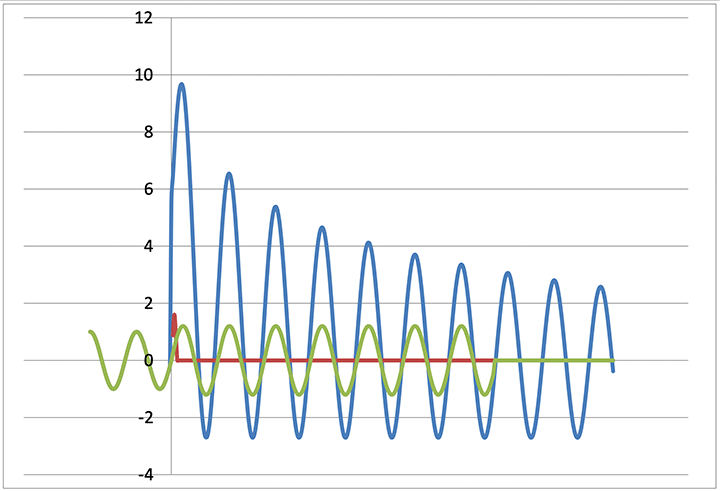Protection
NREL researchers are working to address protection issues introduced by the increasing use of inverter-based resources on power grids.
Protection issues arise because inverters have fault characteristics that are significantly different from those of traditional synchronous generators. Synchronous generators produce approximately six times rated current during a fault, while inverters can be programmed to respond to faults in different ways.

Two inverter responses are shown here. In one, the inverter recognizes the fault condition and disconnects very quickly. In the other, the inverter rides through the fault for seven cycles before disconnecting. Note that both of these responses are very different from the synchronous generator and therefore would change over-current protection schemes on the grid.
This large fault current is often used as a signature for certain types of faults and the basis for time-overcurrent relay protection. A protective relay can sense the large fault current and trip a circuit breaker to protect grid components. But inverter-based power sources do not have the same fault characteristics as synchronous generators. They can typically provide only a small amount above rated output current. In inverter-dominated systems, this may mean the protective relays do not sense the fault.
On the other hand, inverters can react extremely quickly to grid disturbances and may be able to disconnect from the grid, avoiding thermal overload on grid components. A unique characteristic of inverters is that their fault current can be programmed. They can sense a fault extremely quickly and stop producing current within one-fourth of a cycle, or they can be designed to continue to provide current for several cycles through a fault condition.
One possible solution for the lack of high fault currents is to use synchronous condensers to provide fault current. Synchronous condensers are machines that provide only reactive power but can also provide the inertia and fault characteristics of synchronous generators. Besides fault current provision, synchronous condensers bring two other important benefits to the system: mechanical inertia and voltage control. As a result, many integration studies have looked at the possibility of converting large, retiring thermal plants into synchronous condensers for these purposes. Another option is to eliminate overcurrent protection schemes and develop more advanced protection schemes that use current differential or other methods to detect and clear faults.
An additional protection scheme used on the grid is based on special relays that measure the rate of change of frequency (ROCOF). The controllers in ROCOF relays examine the derivative of the frequency to determine if a fault is occurring on the grid. With less system inertia, the rapid decline or rise in frequency during an abnormal event may require changes to the ROCOF settings or even the elimination of their use.
Publications
Traveling Wave Relays for Distribution Feeder Protection with High Penetrations of Distributed Energy Resources, IEEE Rural Electric Power Conference (2021)
Traveling Wave Relays for Distribution Feeder Protection With High Penetrations of Distributed Energy Resources, NREL Presentation (2021)
Advanced Distribution Protection for High Penetration of Distributed Energy Resources (DER), NREL Poster (2019)
Transmission System Protection Screening for Integration of Offshore Wind Power Plants, Renewable Energy (2018)
Contact
Kumaraguru Prabakar
Senior Electrical Engineering Researcher
Kumaraguru.Prabakar@nrel.gov303-275-3178
Share
